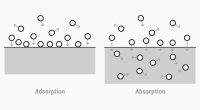In recent agricultural research, the role of 5-Aminolevulinic acid (ALA) in promoting sucrose accumulation in plants has garnered significant attention. Notably, the study “ALA Promotes Sucrose Accumulation in Early Peach Fruit by Regulating SPS Activity,” led by researchers Zheng Chen, Xin Guo, Jinhua Du, and Mingliang Yu, explores the impact of this compound on peach fruit sweetness. ALA, a plant growth regulator and crucial precursor in the biosynthesis of porphyrin compounds, has shown potential in enhancing fruit quality by increasing sugar content. This research specifically examines how ALA-induced sucrose increase in peaches correlates with the activity of sucrose phosphate synthase (SPS), a key enzyme in sugar metabolism.
The study presents compelling evidence that ALA treatment significantly enhances both the sucrose content and SPS activity in peach fruit across various developmental stages. Through detailed analysis and bioinformatics approaches, the team identified specific genes within the SPS family that respond to ALA treatment, shedding light on the genetic mechanisms underpinning this effect. The research findings not only deepen our understanding of ALA’s role in fruit sugar metabolism but also suggest potential agricultural practices for improving fruit sweetness naturally. This study stands as a pivotal contribution to both the scientific community and commercial fruit cultivation, promising to influence future approaches in horticulture and plant physiological research.
The exploration of 5-Aminolevulinic Acid (ALA) in agriculture, particularly its effect on sucrose accumulation, represents a groundbreaking advancement in understanding and manipulating plant metabolism for enhanced crop quality. The use of ALA to induce sucrose increase in peaches aligns with ongoing efforts to meet consumer demand for sweeter fruit without the application of synthetic chemicals. This approach supports a broader movement towards sustainable and environmentally conscious farming practices.
As consumers increasingly favor natural products with improved taste and nutritional value, the agricultural industry faces the challenge of enhancing fruit quality while minimizing ecological footprints. Sucrose, the main sugar found in many fruits, is a critical determinant of the sweetness and overall appeal of fresh produce. Hence, strategies to naturally increase sucrose content are invaluable. The emphasis on ALA-induced sucrose increase in peaches by the recent study serves not only to fulfill consumer preferences but also to bolster the economic viability of peach cultivars.
Prior research has demonstrated the role of ALA as a precursor in the biosynthesis of tetrapyrroles, which are essential for chlorophyll formation and the enzymatic activities involved in plant resilience and productivity. Its application in horticulture, however, has been predominantly focused on enhancing plant growth and stress tolerance. The novel focus on sugar metabolism, as explored in this recent study, opens new avenues for the use of ALA in agriculture.
The research spearheaded by Zheng Chen, Xin Guo, Jinhua Du, and Mingliang Yu provides critical insights into the biochemical pathways influenced by ALA. By examining the correlation between ALA treatment and the activity of sucrose phosphate synthase (SPS), a pivotal enzyme in the synthesis of sucrose, this study sheds light on how ALA can be strategically used to boost sucrose levels in peach fruit. Enhanced SPS activity suggests that ALA may influence the flux of carbon towards sucrose synthesis, a hypothesis supported by the observed increase in sucrose concentration in treated fruits.
Furthermore, the study’s use of bioinformatics to pinpoint the genes within the SPS family that are responsive to ALA highlights the potential of integrating modern technology in traditional agriculture. This integration not only enhances the precision of breeding strategies aimed at sweetness traits but also contributes to a deeper genetic understanding that could be applied across different fruit crops.
This pivotal research on ALA-induced sucrose increase in peaches hence positions itself at the confluence of agricultural technology and consumer-oriented production, suggesting a template for future research and cultivation practices that could transform fruit agriculture into a more sustainable, productive, and economically viable sector. By continuing to clarify the molecular mechanisms through which natural compounds like ALA enhance crop traits, scientists and growers can collaborate to produce tastier, healthier fruits that are aligned with global sustainability goals.
To investigate the ALA-induced sucrose increase in peaches, the researchers adopted a comprehensive methodology integrating field experiments, laboratory biochemical assays, and advanced bioinformatics analysis. They structured their study to meticulously examine how 5-Aminolevulinic Acid (ALA) affects the sucrose content and the activity of sucrose phosphate synthase (SPS) during the critical growth phases of peach fruit.
**Experimental Design and Treatment:**
The research began with the selection of a commercial peach orchard where uniformity in age, size, and health of the peach trees was noted. Randomized blocks of peach trees were established, with each block receiving different concentrations of ALA (0, 25, 50, 100 mg/L) sprayed biweekly during the early stages of fruit development. This dose-dependence study was designed to identify the optimal ALA concentration for enhancing sucrose synthesis in peaches.
**Sample Collection and Processing:**
Peach fruits were collected at multiple developmental stages, i.e., initial fruit set, pit hardening, and pre-harvest. The collected samples were immediately frozen in liquid nitrogen and stored at -80°C to preserve their biochemical integrity for subsequent analyses.
**Biochemical Assays:**
To quantify sucrose content and SPS activity, the researchers employed specific enzymatic assays. Sucrose concentration was measured using high-performance liquid chromatography (HPLC), while SPS activity was analyzed through a combination of enzyme extraction followed by activity assays using reaction mixtures that mimic the enzyme’s natural substrate and product formation conditions.
**Gene Expression and Bioinformatics Analysis:**
RNA extraction was performed from the treated and control fruit samples, followed by cDNA synthesis. Quantitative real-time PCR (qRT-PCR) was then conducted to measure the expression levels of genes encoding SPS enzymes. For a broader genetic analysis, next-generation sequencing was used to profile the entire transcriptome of the treated versus control samples. Bioinformatics tools were employed to identify differentially expressed genes related to sucrose metabolism and ALA response. A particular focus was placed on genes within the SPS family to determine if their expression correlated with observed increases in enzymatic activity and sucrose content.
**Statistical Analysis:**
Data obtained from biochemical and genomic analyses were statistically evaluated using ANOVA to confirm the significance of the observed effects of ALA on sucrose accumulation and SPS activity. Correlation analyses were also conducted to link gene expression patterns directly with enzymatic activity and sucrose levels.
Through this rigorously designed methodology, the study effectively illuminated the biochemical and genetic pathways through which ALA enhances sucrose production in peach fruits. The findings demonstrated that ALA-induced sucrose increase in peaches could be significantly attributed to the upregulated activity of the SPS enzyme, thus presenting a viable method for naturally enhancing fruit sweetness, which is crucial for consumer satisfaction and market value. This integrative approach sets a precedent for future agricultural practices aiming to improve crop quality through natural plant growth regulators.
The key findings of the research on ALA-induced sucrose increase in peaches, led by Zheng Chen and collaborators, highlight a significant advancement in our understanding of how 5-Aminolevulinic Acid (ALA) interacts with the metabolic pathways of fruit development to enhance their sweetness naturally. Through meticulous experimentation and analysis, the study demonstrated that ALA treatment substantially improves both sucrose content and activity of sucrose phosphate synthase (SPS), a critical enzyme involved in the synthesis and accumulation of sucrose in plants.
One of the paramount discoveries was that ALA significantly increases the concentration of sucrose in peach fruits at various developmental stages. The biochemical assays showed a dose-dependent increase in sucrose levels; the peaches treated with the higher concentrations of ALA (50 and 100 mg/L) exhibited the most pronounced enhancement in sucrose content compared to control groups. This finding suggests that ALA functions as a potent enhancer of the biochemical processes leading to sucrose accumulation, making the fruits substantially sweeter.
Moreover, the study established a clear and positive correlation between ALA treatment and SPS activity. Enzymatic assays revealed that ALA-treated peach fruits had significantly higher SPS activity across all tested stages of fruit development. This increase in enzyme activity was closely correlated with the elevated sucrose levels in the fruits, underpinning the role of SPS as a pivotal enzyme in the regulation of sucrose biosynthesis.
In addition to these biochemical results, the research utilized advanced bioinformatics tools to investigate the genetic basis underlining these effects. Gene expression analysis indicated that several genes within the SPS family were upregulated in fruits treated with ALA compared to the controls. This upregulation was most notable in genes directly associated with sucrose synthesis pathways, which corresponds to the increased enzymatic activity and sucrose accumulation. These gene expression patterns provided a genetic blueprint linking ALA application to enhanced sucrose synthesis at the molecular level.
Interestingly, the study also revealed that the application of ALA did not negatively impact other aspects of peach fruit development. The fruits remained physiologically healthy and showed no signs of stress or developmental abnormalities, indicating that ALA could be a safe and effective means of increasing fruit sweetness without compromising plant health or fruit quality.
In summary, the research on ALA-induced sucrose increase in peaches presents powerful evidence that ALA can significantly enhance fruit sweetness through its effect on the activity of sucrose phosphate synthase and the corresponding genetic pathways. This finding not only advances our understanding of plant metabolism but also opens up new possibilities for using natural growth regulators like ALA to improve fruit quality in a sustainable and environmentally friendly manner. The implications of these results are promising for the agricultural industry, offering potential strategies for meeting consumer demands for naturally sweeter fruits and boosting the economic viability of fruit crops like peaches.
The groundbreaking study on the ALA-induced sucrose increase in peaches marks a significant milestone in the field of agricultural science, particularly in enhancing fruit sweetness naturally. The promising results of this research pave the way for future investigations focused on optimizing the application of 5-Aminolevulinic Acid (ALA) and understanding its broader impacts on various crop species. Further studies could explore the dosage and timing nuances of ALA application for optimal sucrose enhancement without negatively affecting plant growth and development, ensuring that the benefits of ALA treatment are maximized for various types of fruits beyond peaches.
Additionally, long-term field studies are essential to investigate the environmental impacts and sustainability aspects of continuous ALA use in agriculture. Researchers should assess the ecological footprint of ALA production and use, aiming to maintain an ecological balance while improving crop quality. Another intriguing avenue for future research is the exploration of ALA’s potential synergistic effects with other natural plant growth regulators. This could provide a more holistic approach to crop management and fruit quality enhancement, potentially leading to innovative agricultural practices that are both efficient and environmentally friendly.
The integration of advanced genomic tools and bioinformatics will continue to play a critical role in these studies. By deepening the genetic understanding of ALA’s interaction with plant metabolic pathways, scientists can fine-tune their approaches to gene expression and enzyme activity regulation. This could lead to the development of targeted genetic modifications or breeding programs that capitalize on the natural benefits of ALA, enabling the cultivation of fruit varieties with naturally enhanced sugar content and superior taste profiles.
Consumer preferences are increasingly leaning towards naturally sweetened and nutritionally enhanced fruits. The insights gained from the ALA-induced sucrose increase in peaches provide valuable knowledge that can help meet these consumer demands. By increasing sucrose content naturally, the fruit industry can reduce the need for post-harvest sugar enhancements or artificial sweeteners, offering products that are not only tastier but also healthier and more appealing to health-conscious consumers.
In conclusion, the study on ALA-induced sucrose increase in peaches not only contributes significantly to our understanding of plant biochemistry and genetics but also offers a promising template for future agricultural practices. The ability to naturally enhance fruit sweetness through ALA treatment embodies a stride toward more sustainable agricultural outputs. As the global agricultural sector continues to evolve, the role of natural plant growth regulators like ALA in improving fruit quality and meeting market demands will undoubtedly become a cornerstone of modern horticultural science and commercial farming. These advances ultimately benefit consumers and producers alike, fostering a sustainable, productive, and economically viable agricultural future.









